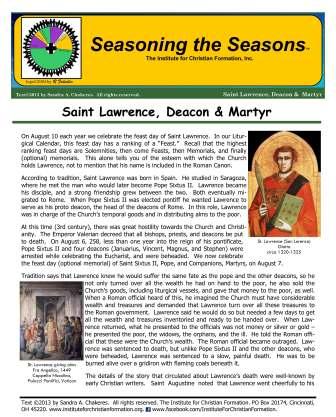The Institute for Christian Formation
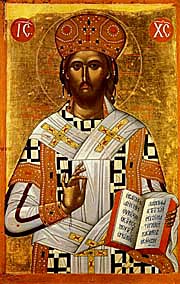
Saint Lawrence, Deacon & Martyr
Feast Day (Feast): August 10
On August 10 each year we celebrate the feast day of Saint Lawrence. In our Liturgical Calendar, this feast day has a ranking of a “Feast.” Recall that the highest ranking feast days are Solemnities, then come Feasts, then Memorials, and finally (optional) memorials. This alone tells you of the esteem with which the Church holds Lawrence, not to mention that his name is included in the Roman Canon.
According to tradition, Saint Lawrence was born in Spain. He studied in Saragoza, where he met the man who would later become Pope Sixtus II. Lawrence became his disciple, and a strong friendship grew between the two. Both eventually migrated to Rome. When Pope Sixtus II was elected pontiff he wanted Lawrence to serve as his proto deacon, the head of the deacons of Rome. In this role, Lawrence was in charge of the Church’s temporal goods and in distributing alms to the poor.
St. Lawrence (San Lorenzo)
Giotto
circa 1320-1325
At this time (3rd century), there was great hostility towards the Church and Christianity. The Emperor Valerian decreed that all bishops, priests, and deacons be put to death. On August 6, 258, less than one year into the reign of his pontificate, Pope Sixtus II and four deacons (Januarius, Vincent, Magnus, and Stephen) were arrested while celebrating the Eucharist, and were beheaded. We now celebrate the feast day (optional memorial) of Saint Sixtus II, Pope, and Companions, Martyrs, on August 7.
St. Lawrence giving alms
Fra Angelico, 1449
Cappella Niccolina, Palazzi Pontifici, Vatican
Tradition says that Lawrence knew he would suffer the same fate as the pope and the other deacons, so he not only turned over all the wealth he had on hand to the poor, he also sold the Church’s goods, including liturgical vessels, and gave that money to the poor, as well. When a Roman official heard of this, he imagined the Church must have considerable wealth and treasures and demanded that Lawrence turn over all these treasures to the Roman government. Lawrence said he would do so but needed a few days to get all the wealth and treasures inventoried and ready to be handed over. When Lawrence returned, what he presented to the officials was not money or silver or gold – he presented the poor, the widows, the orphans, and the ill. He told the Roman official that these were the Church’s wealth.
The Roman official became outraged. Lawrence was sentenced to death, but unlike Pope Sixtus II and the other deacons, who were beheaded, Lawrence was sentenced to a slow, painful death. He was to be burned alive over a gridiron with flaming coals beneath it.
The details of the story that circulated about Lawrence’s death were well-known by early Christian writers. Saint Augustine noted that Lawrence went cheerfully to his death, reportedly saying to his torturers, as he was being roasted alive on the gridiron, "This side is done, turn and eat". Lawrence was put to death on August 10, 258, just four days after Pope Sixtus II and the other four deacons were martyred.
The name “Lawrence” means “Crowned with Laurel.” There are many people, male and female, who are named for Saint Lawrence. If you are named Larry, Lars, Laurel, Lauren, Laurence, Laurent, Laurenz, Laurie, Laurence, Lorenzo, Lonny, Loren, or Renzo – or another derivative of the name Lawrence – August 10 is your feast day! Because of the manner in which Saint Lawrence was put to death, and the cunning remark he was reported to have said while being martyred, one tradition on his feast day is to celebrate with an outdoor barbeque or cookout. And because of Saint Lawrence’s devotion to the poor, you might also honor him by almsgiving on his feast (and throughout the year!).
Saint Lawrence’s feast day is also celebrated by Eastern Rite and Orthodox Christians. You can read about Saint Lawrence (Saint Laurence) at the Greek Orthodox Archdiocese of North America’s web site here.
After Saints Peter and Paul, Saint Lawrence is venerated as the patron of Rome. He is also a patron of the poor, cooks, and even comedians (think again of the remark he reportedly made while being burned alive!).
Like Saint Lawrence, following the teachings of Jesus, may we, too, always know that the poor are the treasure of the Church. We have a wonderful example of how to live this teaching daily from our current pope, Pope Francis.
Follow us on Facebook to keep up to date with our news and newest resources!
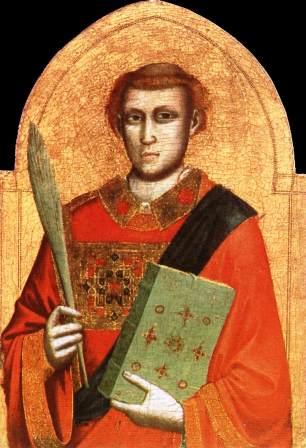
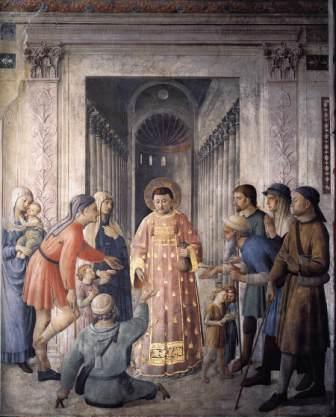
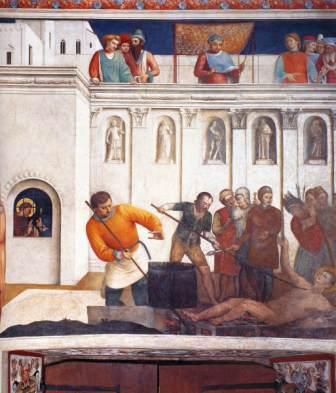
Martyrdom of St. Lawrence
Fra Angelico, 144-1449
Cappella Niccolina, Palazzi Pontifici, Vatican
The story of Lawrence’s life and martyrdom spread quickly amongst the early Christians, and his feast day was celebrated from early on. A church, St. Lawrence outside the Walls (San Lorenzo fuori le Mura), was built over the grave of St. Lawrence in Rome. San Lorenzo is one of the five patriarchal basilicas and one of the seven pilgrimage churches of Rome. You can learn more about this basilica here, and take a video tour of it below.
Click on the image above to download our ICF handout on Saint Lawrence, Deacon & Martyr.
